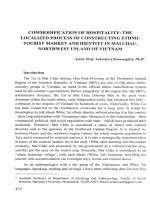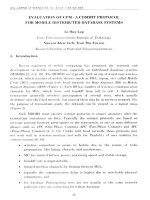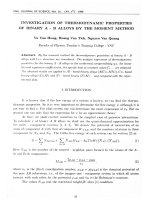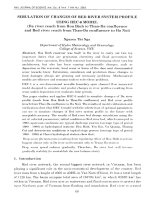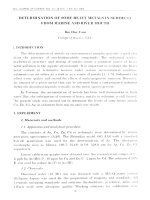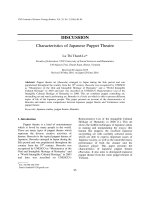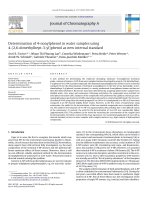DSpace at VNU: Fabrication of Solid Contact Ion Selective Electrode for Mercury (II) Using Conductive Polymer Membrane
Bạn đang xem bản rút gọn của tài liệu. Xem và tải ngay bản đầy đủ của tài liệu tại đây (1.42 MB, 3 trang )
Materials Transactions, Vol. 56, No. 9 (2015) pp. 1428 to 1430
Special Issue on Nanostructured Functional Materials and Their Applications
© 2015 The Japan Institute of Metals and Materials
Fabrication of Solid Contact Ion Selective Electrode
for Mercury (II) Using Conductive Polymer Membrane
Pham Thi Ngoc Mai+ and Phan Tri Hoa
Faculty of Chemistry, Hanoi University of Science, Vietnam National University,
19 Le Thanh Tong, Hanoi, Vietnam
A solid-contact ion-selective electrode for mercury (II) ions was fabricated to determine Mercury (II) in aqueous environment. A
conductive polymer membrane (polypyrrole-PPy) was synthesized electrochemically on paste carbon electrode, which is covered by the ionselective membrane (ISM) ® an important part of a complete solid contact ion selective electrode (SCISE). The electrode showed excellent
potentiometric response over a wide concentration range from 10¹9 M to 10¹2 M and detection limit down to 6 © 10¹10 M. A good selectivity
towards Hg2+ ions in comparison with other common ions in water has also been observed. The electrode was employed for determination of
Hg2+ in ballast water samples with high sensitivity and accuracy. [doi:10.2320/matertrans.MA201562]
(Received February 2, 2015; Accepted April 8, 2015; Published June 5, 2015)
Keywords: solid contact ion selective electrode, mercury (II) determination, conductive polypyrrole
1.
Introduction
Mercury is one of the most toxic elements impacting
human and ecosystem health. A wide range of mercury
species exist within our environment, among which Mercury
(II) is the most common oxidation state in nature.1) An
understanding of mercury species transformations and
accurate monitoring of mercury (II) compounds in the
environment hence are essential for reliable risk assessment.
Common techniques to determine traces of mercury species
in the environment include Atomic Absorption Spectrometry-AAS, Atomic Fluorescent Spectrometry-AFS and Anodic
Stripping Voltammetry-ASV, however these techniques
require expensive instrument and complicated analysis
procedures.2) The use of Ion-selective electrode (ISE) is
a better alternative due to its high selectivity, effective
response simplicity and low cost.3,4) Usually, ISE consists
of internal solution containing analyte ions with fixed
concentration so that a potential can be developed between
the two sides of the ion-membrane. However, the internal
solution is easy to get leaked, cannot stand of pressurized
working environment, is too sophisticated to handle and
difficult to integrate with continuous analysis system.
Recently, a solid-contact ion selective electrode (SC-ISE)
has been studied, replacing internal solution by a solid
conducting polymer layer.4,5) SC-ISEs have advantages of
cheap fabrication, possibility of a pressurized working
environment and small size, which allows application in
any position such as in a Flow Injection Analysis (FIA)
system, in chromatographic instruments (used as detector)
and in Micro Total Analysis Systems (µ-TAS).4) Several
authors have been successful at fabricating of SC-ISE for
Hg(II) using polypyrrole, polyaniline as conducting polymer
and several sulfur or nitrogen-containing ligands such as 1,3diphenylthiourea, 2-mercaptobenzimidazol as mercury ionophore.47) However the fairly narrow working concentration
ranges from 1 © 10¹2 to 1 © 10¹7 M makes it difficult to
determine trace Hg(II) in environmental samples.
+
Corresponding author, E-mail:
The present study aimed on the fabrication of a solidcontact ion selective electrode for mercury (II), in which
we electrodeposited a conducting polypyrrole layer on the
surface of paste carbon electrode, and finally covered by a
mercury ion-selective membrane. The main components of
mercury ion-selective membrane include a mercury ionophore (Mercury Ionophore I), a plasticizer (DOS) and highmolecular weight PVC which creates a frame of the
membrane to keep other components from being dissolved
into solution.
2.
Experimental Section
2.1 Chemical and reagents
Pyrrole (Reagent grade, 98%), bis(2-etylhexyl) sebacate
(DOS) Selectophore· (² 97.0%), 1,10-Dibenzyl-1,10-diaza18-crown-6 (Mercury Ionophore I), polyvinylchloride (PVC),
Tetrahydrofuran, anhydrous ²99.9%; Hg(NO3)2·H2O ACS
reagent, ²98.0% and HNO3 ACS reagent, 70% were from
Fluka Chemie, Switzerland. Aqueous solutions were prepared by deionized water. Stock mercury (II) solution
(1000 ppm) was freshly prepared. The stock and sample
solutions were kept at 4°C when not in use.
2.2 Electrode preparation
2.2.1 Synthesis of polypyrrole
Polypyrrole was synthesized electrochemically with constant potential at different voltages from 0.6 to 0.9 V in a
solution of pyrrole 0.2 M and KNO3 0.2 M onto the surface of
a paste carbon electrode with inner diameter of 2 mm and
outer diameter of 6 mm. Cyclic Voltammetry (CV) of PPy
was carried out using VA 757 Computrace (Metrohm,
Switzerland) in the solution of Hg(NO3)2 with different
concentrations to dope Hg2+ ions into the PPy membrane and
to examine the conductivity of PPy membrane via the shape
and peak height of the signal curves.
2.2.2 Fabrication of ion-selective membrane solution
An ion-selective membrane (ISM) contains three main
components: ionophore (Mercury Ionophore I) (6%), plasticizer (bis(2-etylhexyl) sebacate - DOS) (64%) and polymer
Fabrication of Solid Contact Ion Selective Electrode for Mercury (II) Using Conductive Polymer Membrane
(PVC) (30%). All components are dissolved in 0.5 mL of
THF and stirred for at least 10 hours before being used. The
membrane mixture should be stored at 4°C. A 50 µL microsyringe was used to cover ISM solution on the electrode
surface which was covered with a thin layer of conductive
polymer (PPy). The ISE was conditioned in the solution of
mercury (II) ion before being utilized.
2.3 Potential measurement
The current-free potential measurement was carried out
with a Martini mV/pH meter. The electrode system consists
of SC-ISE as working electrode and Ag/AgCl (KCl 3 M) as
reference electrode. The response of SC-ISE was evaluated
via steady-state measurement at constant ionic strength of
0.1 M KNO3 and pH = 3. Selectivity towards other ions was
measured in terms of the selectivity coefficients using
separate solution method. The environmental samples were
filtered to remove suspended matters and adjust to suitable
pH (3 ª 4) prior to analysis.
3.
1429
(a)
(b)
Results and Discussion
3.1 Deposition of conducting polypyrrole membrane
The electrolysis potential has a significant effect on the
formation of PPy thin film. The PPy thin film was not formed
at voltage of 0.6 V, while at 0.9 V the over-oxidation of PPy
thin film easily occurs. The optimum potential was found as
0.8 V, with the highest current density observed in CV
diagrams. The performance of PPy thin film is also affected
by the electrolysis time. The higher the deposition time, the
thicker the film and the higher the current density is.
However, after 150 s the PPy film becomes saturated and no
higher current density was observed. This is in agreement
with what observed by scanning electron microscopy (SEM)
(see Fig. 1). Electrolysis of 150 s allows PPy to form a fine
membrane on the electrode surface. Less time of deposition is
not enough to form a continuous layer of PPy membrane
while longer time causes cracks on the surface of membrane
due to large amount of PPy synthesized.
CV diagrams of PPy synthesized on paste carbon electrode
with deposition time of 150 s in Hg(NO3)2 solution with
concentration varying from 0.001 M to 0.1 M are presented in
Fig. 2. Since NO3¹ in the membrane can bind to Hg2+ in the
solution to balance the membrane electrically, it can be an
important stage to dope Hg2+ into the PPy membrane and
lead to the improvement in the selectivity of SC-ISEs. It is
clear that different concentrations of Hg(II) significantly
affect CV diagrams both in shape and peak height. The
concentration of Hg(NO3)2 0.1 M was chosen for the
synthesis since the CV curve shows a smooth shape with
highest peak value of about 500 µA.
3.2 Potentiometric measurement of SC-ISE
3.2.1 Potentiometric response of SC-ISE towards Hg2+
ion
The SC-ISE needs about 60 seconds to reach a constant
value. The response time is longer as compared to normal
ISE (30 ª 45 s) since Hg2+ ions need more time to diffuse
from the solution through the ISM and then reach the PPy
membrane where the electron exchange process takes place.
Fig. 1
SEM image of PPy membrane after 150 s of deposition.
Fig. 2 CV diagram of PPy synthesized on CP electrode with deposition
time of 150 s in Hg(NO3)2 solution (a) 0.001 M, (b) 0.01 M and (c) 0.1 M.
Linear potentiometric response was observed over a wide
range of Hg2+ concentrations from 10¹9 M to 10¹2 M with
Nerstian slope of 23.7 « 1.4 mV per decade (see Fig. 3), a
typical value for a divalent cation like Hg2+. The equation
of the working curve is E = (23.6 « 1.4) log [Hg2+] +
(195.6 « 14.6) while the LOD of the electrode determined by
the meeting point between two lines is 5.9 © 10¹10 M. The
obtained LOD are markedly lower than values reported by
other studies: (6.1 « 1.7) © 10¹7 M,5) for a Hg-ISE electrode
using a dithiophosphate-based ionophore and 1 © 10¹6 M for
a Hg-ISE electrode using 1,3-diphenylthiourea ionophore.6)
This extremely LOD value allows the use of method for
determination of Hg2+ in environmental samples.
1430
P. T. N. Mai and P. T. Hoa
Table 1 Comparison of results of analysis of mercury in water samples by
the CV-AAS and SC-ISE method.
Sample
4.
Fig. 3 Potential response of PC-based SCISE with 6% of ionophore.
3.2.2 Selectivity towards to other cations
The measured selectivity coefficients of various cations
including H+, K+, Na+, Cu2+, Ca2+, Fe2+, Mg2+, Pb2+,
Cd2+, Mn2+ and Zn2+ are in the range of 0.4 to 10¹3, much
lower than 1, indicating that these cations have little
interference when present with Hg2+ ion in the solution.
The interference order is alkali ions > alkaline ions > transition metal ions > H+, which is in agreement with other
studies on Mercury (II) ion selective electrode.6,7) Only Ag+
significantly affects the selectivity of SC-ISEs with high
3
value of Kpot
ij of 10 . This significant influence is possibly due
to the good complexation between Ag+ and 1,10-Dibenzyl1,10-diaza-18-crown-6 ionophore.8) However, the electrode
can tolerate Ag+ ions at concentrations lower than 10¹6 M,
which is a common observed concentration in water samples.
3.2.3 Application in analysis of real sample
To assess the applicability of the SC-ISE to real samples,
we determined mercury in synthetic solutions and three of
ballast waters. Ballast samples were pre-treated with nitrous
acid to avoid precipitation, centrifuged to isolate suspended
matters and adjusted to pH 3 ª 4 using drops of concentrated
nitric acid and ammonia. The standard addition method was
applied for the analysis of Hg in ballast water samples.
Results were compared with those measured by atomic
absorption spectrometry (AAS). Results are summarized in
Table 1 and show the good agreement between the two
methods. The amount of Hg found in ballast water is below
the danger level given by US-EPA.
Concentration of Hg2+ (ppb)
SC-ISE
AAS
Synthetic 1
5.4 « 0.6
6.0 « 0.4
Synthetic 2
39.2 « 2.1
38.2 « 1.1
Ballast water 1
5.4 « 0.4
5.6 « 0.4
Ballast water 2
12.3 « 0.3
11.7 « 0.2
Ballast water 3
8.1 « 0.8
7.9 « 0.3
Conclusions
This work demonstrates that a conducting polypyrrole
layer can be used to replace the internal solution in the
development of solid contact selective ion electrode for
Hg2+. The electrode responds to Hg2+ ion in a Nerstian
fashion and presents a good selectivity and low detection
limit down to 6 © 10¹10 M. The electrode is characterized by
a relatively fast response, high selectivity and was successfully applied to the determination of Hg2+ in ballast water
samples. Our results suggest that in the future solid-contact
ion selective electrode can become a vital part of environmental analysis with a wide range of application, particularly
for field analysis.
Acknowledgements
This study was supported by Project QG.13.08 funded by
Vietnam National University, Hanoi (VNU-HUS).
REFERENCES
1) L. Friberg: Inorganic Mercury, Environmental Health Criteria 118,
(World Health Organization, ISBN 92-4-157118-7, Geneva, 1991).
2) K. Leopolda, M. Foulkesb and P. Worsfoldb: Anal. Chim. Acta 663
(2010) 127138.
3) M. Mazloum, K. M. Amini and I. Mohammadpoor-Baltork: Sens.
Actuators B 63 (2000) 8085.
4) X. Yu, Z. Zhou, Y. Wang, Y. Liu, Q. Xie and D. Xiao: Sens. Actuators
123 (2007) 352358.
5) J. J. Gomez, F. P. Garcia, M. T. R. Silva, A. R. Hernandez, C. A. G.
Vidal and M. E. P. Hernandez: Talanta 114 (2013) 235242.
6) L. P. Marin, E. O. Sanchez, G. M. Miranda, A. Perez, J. A. Chamaro and
H. L. Valdivia: Analyst 125 (2000) 17871790.
7) W. S. Han, K. C. Wi, W. S. Park and T. K. Hong: Russi. J. Electrochem.
48 (2012) 525531.
8) G. H. Rounaghi, M. Mohajeri, S. Ashrafi, H. Ghasemi, S. Sedaghat and
M. Tayakoli: J. Inclusion Phenomena Macrocyc. Chem. 58 (2007) 16.

